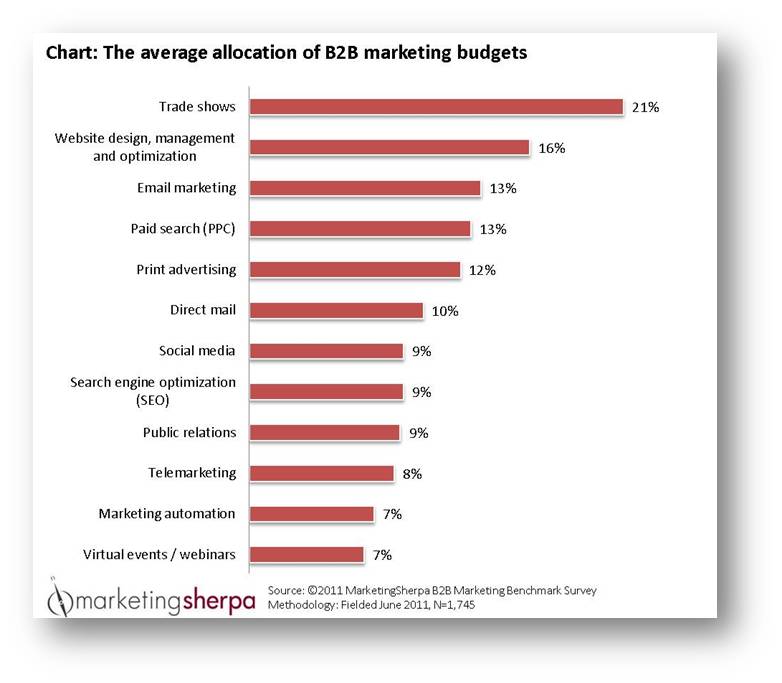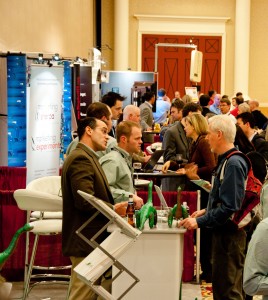Trade Show Follow-Up: 5 tips to optimize response
Originally published on B2B LeadBlog
For the past seven years, trade shows have surpassed websites, email marketing and paid search to secure the top spot as B2B marketers? biggest investment, according to the MarketingSherpa 2012 B2B Marketing Benchmark Report.
 But, do marketers make the most of this investment? I can’t help but wonder given my own trade show attendance experience.
But, do marketers make the most of this investment? I can’t help but wonder given my own trade show attendance experience.
For weeks after, I unsubscribe from newsletters and sales pitches from companies I barely recognize.
Here’s what I suspect happens:
- They sponsor the event and set up a booth.
- They put together a list of attendees’ contact info based on collected business cards, contest entries and captures from the dreaded lead guns, which instantly gather contact information by scanning trade show badges.
- They dump this list into their database.
- Attendees automatically receive whatever they’re already sending to their email lists.
Trade Show ≠ Instant Engagement
Just because someone attends a trade show does not mean that every organization in attendance is relevant to her, or that she is eager to receive newsletters, the latest product updates or a sales call. Too many companies wrongly assume trade show attendance equals instant engagement.
If you don’t want to be banished to the spam file or voicemail, take the succeeding steps when following up with trade show prospects:
- Invite or welcome them to your email list. Explain how you attained their names, make it personal and connect back to their motivation. Example: “I hope you enjoyed the conference as much as I did. We really believe in (core event values).”If they chatted with a sales professional, reference that conversation. Do what you can to show what you have in common (primarily, the event) and why they should engage with your company.
- Create event-related content. Again, the event is what connects you. Write articles and blogs about it. Interview the event’s subject matter experts. Bring along a reporter. Demonstrate your value to attendees by providing a fresh perspective and helping them assimilate even more knowledge. After all, that’s why they attend conferences and trade shows. Use this content as part of a nurturing campaign, as outlined below.
- Don’t sell, nurture. Only 5% to 15% of inquiries are ready to speak to Sales, so the rest require nurturing until they fit your universal lead definition (ULD). (Don’t have one? Make one. Find out how here: “Universal Lead Definition: Why 61% of B2B marketers are wasting resources and how they can stop.”)Develop a lead-nurturing campaign to guide prospects through the marketing funnel until they’re ready to speak to Sales. Find out how to do that here: “Lead Nurturing: You could be losing as much as 80% of your sales; here’s how you keep them.”
- Encourage your salespeople to make personal connections. Make sure your sales professionals individually follow up with the people they spoke with, whether that’s through sending email, connecting on LinkedIn, or following them on Twitter. People build relationships with people, not companies.
- Keep them engaged, even if they’re never going to be a customer. Don’t discard attendees who are not a fit; they could become a champion of your brand, or possibly a partner or collaborator. Engage them by developing a nurturing campaign that will keep them abreast of what’s happening in your organization. Invite them to subscribe to an online newsletter, attend online events, or connect via social media.
Want to learn more about how to make the most of your trade show investment? Check out this article: “9 Simple Tactics to Drive a Higher Return on Trade Show Investment.”
Do you have additional recommendations to optimize trade show follow-up? Feel free to share them in the comments. I would love to hear your ideas.
Related Resources:
MarketingSherpa Email Summit 2013 — February 19-22 in Las Vegas
How to Use Lead Scoring to Drive the Highest Return on Your Trade-Show Investment
Lead Generation: 39% say offline lead gen has somewhat decreased









